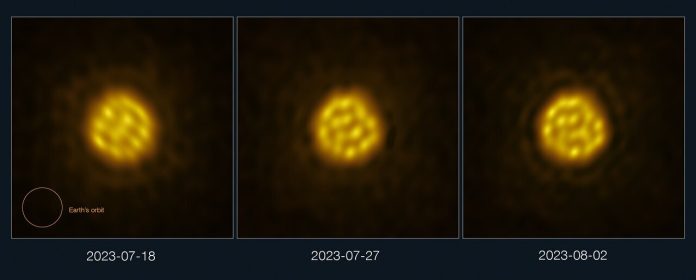
For the first time, astronomers have captured detailed images of a star other than the sun, showing the motion of hot, bubbling gas on its surface.
Using the Atacama Large Millimeter/submillimeter Array (ALMA) telescope, scientists observed the red giant star R Doradus, located about 180 light-years away in the constellation Dorado.
The images revealed massive bubbles of gas, 75 times the size of the sun, rising and sinking on the star’s surface faster than expected.
The research, led by Wouter Vlemmings, a professor at Chalmers University of Technology in Sweden, was published in Nature.
“This is the first time we’ve been able to capture such detailed images of a star’s bubbling surface,” Vlemmings said.
“We never thought we’d be able to see convection on a star like this in such detail.”
Stars, including the sun, produce energy in their cores through nuclear fusion.
This energy is carried to the surface by massive bubbles of hot gas, which cool down and sink back into the star’s interior in a process known as convection.
It’s similar to the movement of a lava lamp, with hot material rising and cooler material sinking. This mixing process helps distribute heavy elements like carbon and nitrogen throughout the star.
Until now, scientists had only been able to track convection motions on the sun. However, by using ALMA, the research team obtained high-resolution images of R Doradus over a month, allowing them to track the movement of gas bubbles on its surface.
R Doradus is a red giant star, about 350 times the size of the sun, and is considered an ideal candidate for study due to its large size and relatively close distance to Earth.
Its mass is also similar to the sun’s, making it a good comparison for how our sun might look in about five billion years when it becomes a red giant.
“Convection creates the beautiful, granular structure we see on the surface of the sun, but it’s much harder to observe on other stars,” said Theo Khouri, a co-author of the study. “With ALMA, we were able to not only see the convective granules on R Doradus but also measure their speed for the first time.”
Interestingly, the bubbles on R Doradus move faster than scientists expected, completing a full cycle in about one month. This is different from what has been observed on the sun, and researchers are still trying to understand why convection might change as stars age.
These new observations are helping scientists better understand how stars like the sun behave as they grow older and larger. Ph.D. student Behzad Bojnodi Arbab, who was involved in the study, added, “It’s amazing that we can now directly see details on the surface of stars so far away and study the same physics we observe on our own sun.”
This breakthrough offers valuable insight into the life cycles of stars and the processes that shape the universe.



